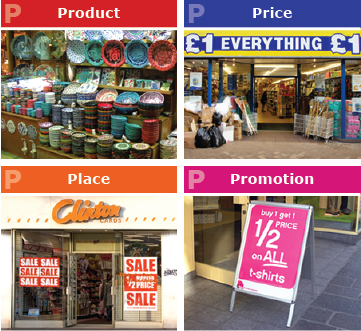2.1 The retail marketing mix
Marketing is an underlying philosophy that guides business activities, but how does a retailer do marketing? A retailer must engage in planning, research and analysis before implementing a marketing strategy. At the core of any retail marketing plan is the mix consisting of the four Ps (Product, Price, Place and Promotion) of marketing. The following images show retail examples of each of the elements of the mix and the next activity describes each element of the mix further.

Activity 5: Reading about the mix
Purpose: this task will help you explore the elements of the marketing mix and develop your understanding of how the mix applies to retailing.
Task: The marketing mix is often called the four Ps and it represents four discreet areas of business planning and marketing decision-making. The four Ps are: Product, Price, Place and Promotion. Find out what is involved and how these concepts relate to retail management by reading the following extracts in Box 1. Then make some notes on what each element of the mix means to the retailer.
Box 1: The four Ps of the marketing mix
Product
In general marketing terms, the product decision involves deciding what goods or services should be offered for sale to a particular group of customers. An important aspect of this element of the mix is new product development. As technology and tastes change, products become out of date and inferior to those of the competition, so companies must update products with features that customers value or completely replace the product. Market leadership can change as new products are developed that give greater benefits than old ones. For example, the Sony Walkman was the market leader in portable music players. Following its launch, the Apple iPod soon outsold the Walkman as it offered the advantages of being able to download music and hold thousands of songs on a much smaller device. From the first iPod, Apple has developed a product range to cater for diverse customer needs.
Product decisions also involve choices regarding brand names, guarantees, packaging and the services that should accompany the product offering. Guarantees can be an important component of the product offering. For example, the operators of the AVE, Spain’s high-speed train, capable of travelling at 300 kmph, are so confident of its performance that they guarantee to give customers a full refund of their fare if they are more than five minutes late.
From a retail marketing perspective, the product element of the mix is very important. Retailers provide stores full of products to suit every consumer’s needs. Some retailers fill their shelves with extensive product ranges (this can be seen here in the image of an extensive range of hair care products) whilst others offer more limited choices of products (as you can see in the image of an exclusive range of jewellery products). The range of products a retailer sells is called the assortment and this defines the nature of the business and its position in the marketplace. By looking at the following two pictures, you can begin to get a feel for the difference in the type of retail operations that might be selling these products.

According to many retailers, the product is the most important element of the retail mix. Selecting what to sell, making the right purchasing decisions, organising stock management and arranging how to display product ranges is so fundamentally important to retail management. However, considered by many retailers to be of equal importance is price.
Price
Price is a key element of the marketing mix because it represents, on a unit basis, what the company receives for the product or service that is being marketed. It is the only element of the marketing mix that creates revenue, while all of the other elements represent costs. For example, expenditure on product design (product), advertising and salespeople (promotion) and transportation and distribution (place) all cost money. Marketers therefore need to be very clear about pricing objectives, methods and the factors that influence price setting. They must also take into account the necessity of discounting and giving allowances in some transactions. These requirements can influence the level of list price chosen, perhaps with an element of negotiation margin built in. Payment periods and credit terms also affect the real price received in any transaction. These kinds of decisions can affect the perceived value of a product.
Because price affects the value that customers perceive they get from buying a product, it can be an important element in their purchase decision. Some companies attempt to position themselves as offering lower prices than their rivals. For example, supermarkets such as Asda (Walmart) in the UK, Aldi in Germany, Netto in Denmark and Super de Boer in the Netherlands employ a low-price positioning strategy.
Another strategy is to launch a low-price version of an existing product targeted at price-sensitive consumers. For example, Apple launched the Mac mini, a basic version of the Macintosh computer. With this low-priced machine Apple believes it can tempt people who have bought an iPod (and become fans of the company) to ditch their Windows-based PCs and switch to the Mac mini.
Many factors affect retail pricing policies. Choosing products and setting prices is an important part of retail management and the next element of the mix, place, focuses on where to sell the product assortment.

Place
Place considerations involve decisions concerning the distribution channels to be used and their management, the locations of outlets, methods of transportation and inventory levels to be held. The objective is to ensure that products and services are available in the proper quantities, at the right time and place.
Distribution channels consist of organisations such as retailers or wholesalers through which goods pass on their way to customers. Producers need to manage their relationships with these organisations well because they may provide the only cost-effective access to the marketplace. They also need to be aware of new methods of distribution that can create a competitive advantage. For example, Dell revolutionised the distribution of computers by selling direct to customers rather than using traditional computer outlets.
Increasingly, music is distributed by downloading from the internet rather than being bought at music shops. Consequently, place is another important part of the mix that influences retail management decision making.
The final element of the mix we are going to consider here is promotion.
Promotion
Retailers constantly communicate with their customers using a variety of methods and approaches. Retail promotions involve the management of elements of the promotional mix, which include advertising, sales promotions, digital and direct marketing, personal selling, sponsorship and public relations.
By these means the target audience is made aware of the existence of a product or service and the benefits (both economic and psychological) it confers on customers. Each element of the promotional mix has its own set of strengths and weaknesses. Advertising, for example, has the property of being able to reach wide audiences very quickly.
Procter & Gamble used advertising to reach the emerging market of 290 million Russian consumers. It ran a 12-minute commercial on Russian television as its first promotional venture in order to introduce the company and its range of products. Advertising can be a powerful tool in a recession. While its competitors cut back on advertising expenditure during the Great Depression of 1929, Procter & Gamble increased its spend. The company dominated radio advertising, bringing market leadership during the 1930s and the creation of the platform that has led to its continuing success to the present day.
Digital marketing via the internet is increasingly important as a promotional tool. A great advantage of the internet is its global reach – companies can now easily extend the reach of their communications to consumers worldwide by creating a website. The internet has also proven to be a powerful communication tool, sometimes replacing traditional media.
Many retailers now sell through the internet, either exclusively or in conjunction with a network of stores and/or paper-based catalogues. The internet brings opportunities for retailers to sell to and communicate with their customers through one highly interactive and flexible channel. In the final part of this course, you will learn about how retailers use marketing communications to engage the interest of their target customers. But before we do this have a go at the following activity.
Activity 6: Applying the retail marketing mix
Purpose: to consider use of the marketing mix in a real organisation.
Task: Imagine you are the Retail Marketing Manager for the National Trust and it is your job to determine how the marketing mix will be applied across the shops, cafés and restaurants the organisation operates around the UK. Reflect on the following question and write a short answer in 100–150 words explaining your reasoning: How does your understanding of the four Ps help you to assist the management of the shops, cafés and restaurants to make decisions that meet the needs of their customers?
Answer
Applying the four Ps of the marketing mix should enable you to:
- select suitable product ranges to sell in the gift shops and decide on the content of the menus in the cafés and restaurants
- set appropriate pricing strategies for shops, cafés and restaurants
- create promotional campaigns to communicate with customers
- develop appropriate locations for gift shops, cafés and restaurants, and organise logistics.
However, while the traditional marketing mix makes provision for planning decisions associated with the product, price, place and promotion the levels of service provided by a retailer are not covered by the four Ps, e.g. does a café operate using self-service or full-service? The four elements of the mix potentially leave us with some unanswered questions, e.g. who are the people involved in serving the customers in the shops and food outlets? How are the interiors of the shops and food outlets decorated and designed? What are the processes involved in serving the customers?
It is important to be aware that the four Ps marketing mix has often been criticised for being too over-simplified in dealing with marketing management issues (Booms and Bitner, 1981). The reality is that where appropriate, the marketing mix can be extended to include people, processes and physical evidence. There is also an argument that some elements may be covered by two or more of the categories. For instance, when L’Oreal launches a new product the in-store sales promotion campaign and the people involved might be discussed under product and/or promotion or both. The key is not to rely on the four Ps as a catchall for planning marketing solutions but to be aware of them as a guide to key areas of marketing that need to be included in retail management planning. Successful management of the marketing mix is achieved through a focus on delivering customer satisfaction and applying the mix appropriately.
What have you learnt about the retail marketing mix?
You have identified and considered the four elements that make up the marketing mix: product, price, place and promotion. You should also have begun to think about the scope and extent to which the four Ps are involved in shaping and informing management decision making in retailing. In Activity 6, you should have noted that retail managers can use the mix as a guide but they should be aware of the need to consider all aspects of the trading situation when planning marketing implementations.
